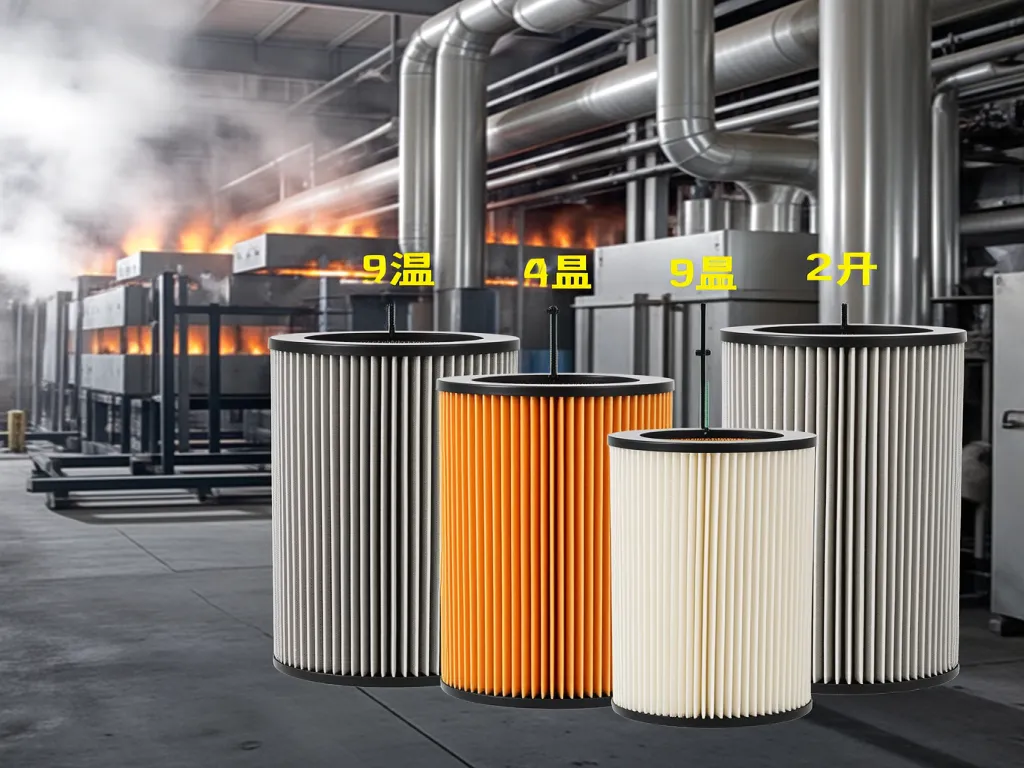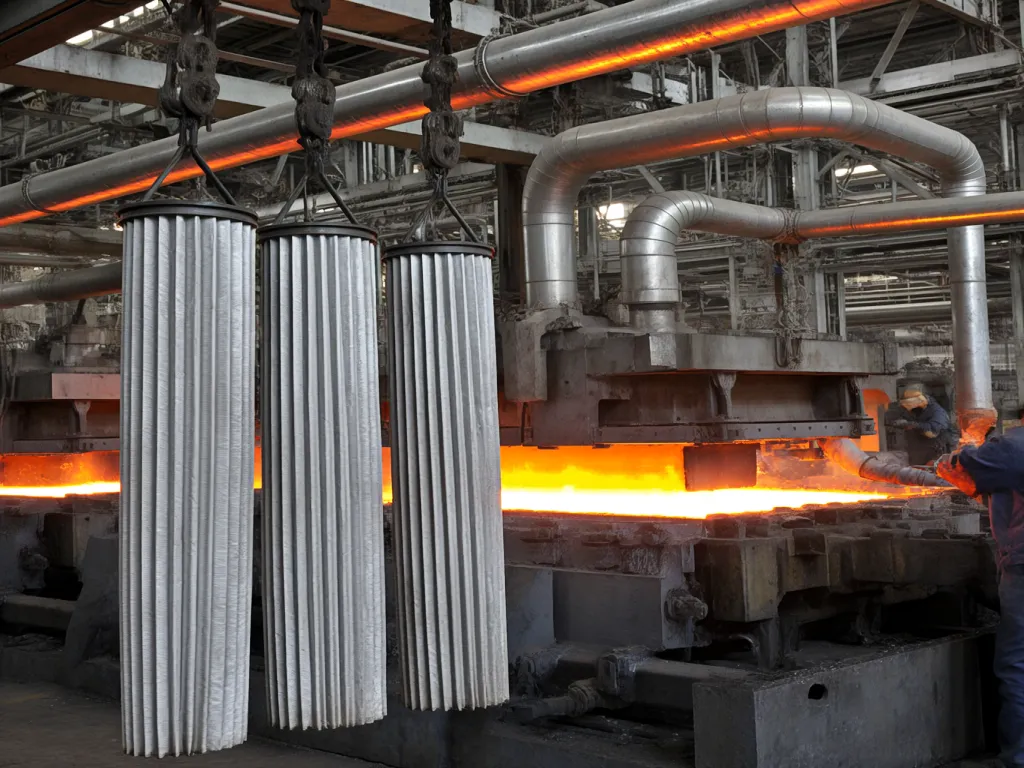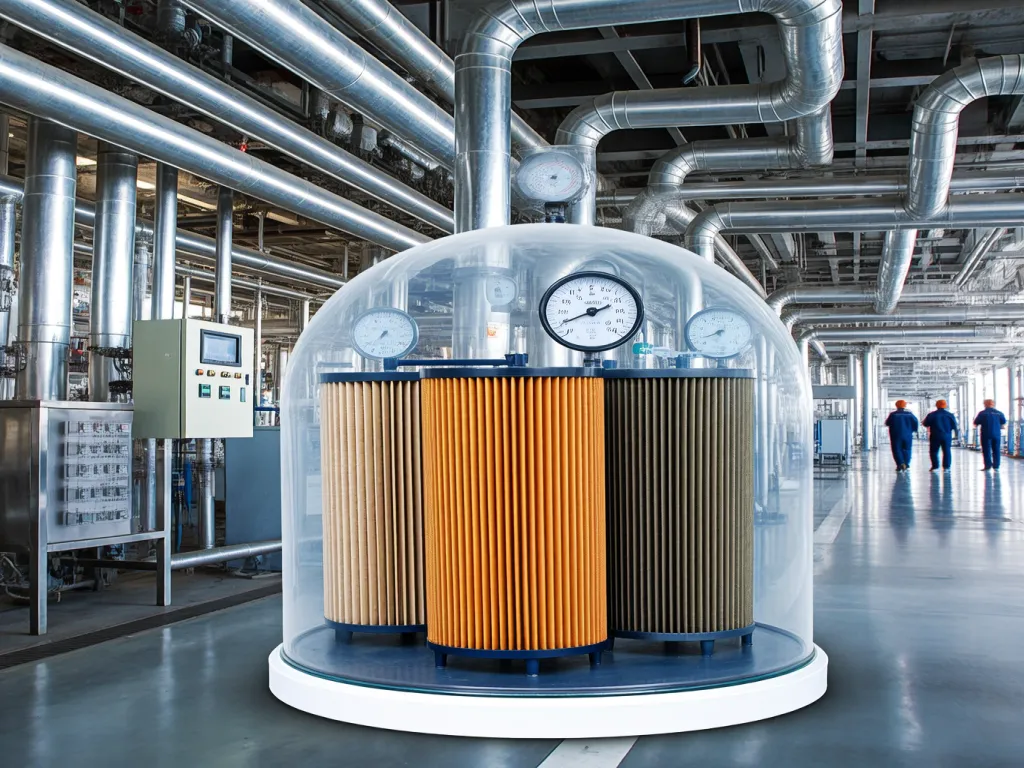High-Temp Heroes: Choosing Pleated Filter Bags Wisely
In industrial settings where temperatures soar, selecting the right filtration solution isn’t just about keeping things clean—it’s about survival. Enter pleated filter bags, the unsung heroes of high-heat environments. But how do you know which pleated filter bags can withstand the scorch without compromising performance? Let’s dive into the critical factors that make some pleated filter bags stand out in extreme heat, ensuring your operations run smoothly and safely.

High – Temperature Environment Guardian: How to Choose the Most Suitable Pleated Filter Bags?
When it comes to industrial processes operating in high – temperature environments, selecting the right pleated filter bags is no small feat. High temperatures bring a unique set of challenges that demand specific characteristics from the filter materials. Let’s dive into the key requirements and explore how different materials of pleated filter bags can meet these demands.
1. The Special Requirements of High – Temperature Environments for Filter Materials
1.1 Heat Resistance
In high – temperature settings, the first and foremost requirement for filter materials is heat resistance. Imagine a scenario where a filter bag is exposed to temperatures exceeding 200°C. If the material can’t withstand this heat, it will quickly degrade. For instance, a common polyester filter bag might start to melt or lose its structural integrity at around 130 – 150°C. This is why materials like P84 (polyimide) and PTFE (polytetrafluoroethylene) are highly valued. P84 can handle continuous operating temperatures up to 260°C, while PTFE can withstand even higher temperatures, often up to 280°C or more. These materials maintain their shape and filtering capabilities, ensuring consistent performance in extreme heat.
1.2 Chemical Stability
High – temperature environments often go hand – in – hand with the presence of various chemicals. Whether it’s acidic fumes from a chemical reaction or alkaline substances in a manufacturing process, the filter material must remain chemically stable. For example, in a power plant’s flue gas treatment system, the gases contain sulfur dioxide and other acidic compounds. If the filter bag material reacts with these chemicals, it can lead to corrosion, reduced filtering efficiency, and even premature failure. Materials such as glass fiber and PTFE are known for their excellent chemical resistance. Glass fiber can resist most acids and alkalis, while PTFE is virtually inert to almost all chemicals, making it an ideal choice for highly corrosive high – temperature applications.
1.3 Mechanical Strength
The mechanical strength of the filter material is crucial in high – temperature environments. As the temperature rises, the material may become more brittle or prone to stretching. A filter bag needs to withstand the pressure of the gas or dust being filtered, as well as the mechanical stress during installation and cleaning. Aramid fibers, for example, offer high tensile strength and good dimensional stability at elevated temperatures. They can handle the physical forces exerted on the filter bag without breaking or deforming, ensuring long – term reliability.

2. Different Materials of Pleated Filter Bags and Their Applicable Scenarios
2.1 P84 Pleated Filter Bags
P84 pleated filter bags are a popular choice for high – temperature applications. Their unique structure, with a high surface area and excellent dust – holding capacity, makes them efficient in capturing fine particles. These bags are commonly used in cement kilns, where the operating temperatures can reach up to 250°C. The high heat resistance of P84 allows it to perform well in this harsh environment, while its chemical stability ensures it can handle the alkaline dust and gases present in the cement – making process. Additionally, P84’s low shrinkage at high temperatures helps maintain the proper fit and function of the filter bag over time.
2.2 PTFE Pleated Filter Bags
PTFE pleated filter bags are the go – to option for extremely high – temperature and highly corrosive environments. In the chemical industry, where reactions often occur at high temperatures and involve strong acids or alkalis, PTFE filter bags excel. Their non – stick surface prevents the buildup of dust and chemicals, reducing the need for frequent cleaning. For example, in a pharmaceutical manufacturing plant that uses high – temperature sterilization processes, PTFE filter bags can effectively filter out contaminants while withstanding the high temperatures and chemical exposure without any degradation.
2.3 Glass Fiber Pleated Filter Bags
Glass fiber pleated filter bags are known for their high temperature and chemical resistance. They are widely used in incinerators, where the flue gas temperatures can be very high, and the gases contain a mix of acidic and alkaline substances. The glass fiber material can withstand these conditions and provide efficient filtration. Moreover, glass fiber filter bags are relatively cost – effective compared to some other high – temperature materials, making them a good choice for applications where budget is a consideration while still requiring reliable high – temperature performance.
2.4 Aramid Fiber Pleated Filter Bags
Aramid fiber pleated filter bags are suitable for high – temperature applications that also involve mechanical stress. In metal smelting processes, for instance, the high temperatures generated during melting and refining are accompanied by the movement of heavy metal particles. Aramid fiber’s high tensile strength allows it to withstand the physical impact of these particles without tearing. Its good heat resistance ensures it can operate effectively in the high – temperature environment of the smelting furnace, providing consistent filtration performance.

Optimizing Filtration Performance: Efficiency and Pressure Drop of Pleated Filter Bags in High-Temperature Environments
When it comes to industrial filtration in high-temperature settings, pleated filter bags are often the unsung heroes. But have you ever stopped to think about how temperature fluctuations affect their filtration efficiency and pressure drop? Let’s dive into the science behind this and uncover some practical strategies to keep your filtration system running smoothly. First off, it’s crucial to understand that as the temperature rises, so does the kinetic energy of the gas molecules passing through the filter. This increased energy can lead to more frequent collisions with the filter media, potentially enhancing filtration efficiency—up to a point. However, beyond a certain threshold, the heat can start to degrade the filter material, leading to a decline in performance. That’s where the magic of pleated filter bags comes into play. Their unique design increases the surface area available for filtration, which can help mitigate some of the efficiency losses caused by high temperatures. But it’s not just about the surface area; the choice of material matters too. Now, let’s talk about pressure drop. In high-temperature environments, the viscosity of the gas can change, affecting the flow rate through the filter. A higher temperature typically means lower viscosity, which could, in theory, reduce the pressure drop across the filter. But again, material degradation and particle buildup can counteract this effect, leading to an increase in pressure drop over time. So, how do you strike the right balance? Here are a few strategies: 1. Material Selection: Opt for high-temperature-resistant materials like PTFE, PPS, or fiberglass. These materials can withstand extreme temperatures without compromising their structural integrity or filtration efficiency. 2. Regular Maintenance: Implement a routine inspection and cleaning schedule. This helps prevent particle buildup and extends the lifespan of your pleated filter bags. 3. Pre-Filtration: Consider adding a pre-filtration stage to remove larger particles before they reach your pleated filter bags. This can significantly reduce the load on your main filters and minimize pressure drop. 4. Differential Pressure Monitoring: Install differential pressure gauges to continuously monitor the pressure drop across your filters. This allows you to detect and address any issues before they escalate. By implementing these strategies, you can ensure that your pleated filter bags continue to perform optimally, even in the most challenging high-temperature environments. Remember, choosing the right filter bags and maintaining them properly is key to achieving long-term filtration success.
Understanding Filtration Efficiency in High Temperatures
Filtration efficiency is a measure of how well a filter can remove particles from a gas stream. In high-temperature environments, this efficiency can be influenced by several factors, including the temperature itself, the type of particles being filtered, and the filter material. As mentioned earlier, higher temperatures can increase the kinetic energy of gas molecules, potentially enhancing filtration efficiency. However, this effect is often offset by material degradation and changes in particle behavior. To maintain high filtration efficiency, it’s essential to select filter materials that are specifically designed for high-temperature applications. These materials should have a high melting point, excellent chemical stability, and good mechanical strength to withstand the rigors of high-temperature filtration.
Managing Pressure Drop for Optimal Performance
Pressure drop is another critical factor to consider when operating pleated filter bags in high-temperature environments. A high pressure drop can indicate that the filter is clogged or that the flow rate is too high, both of which can reduce filtration efficiency and increase energy consumption. To manage pressure drop effectively, start by selecting filter materials with low resistance to airflow. Pleated designs, as mentioned earlier, can help increase surface area and reduce pressure drop. Additionally, regular maintenance, including cleaning and replacement of worn-out filters, is crucial. By keeping your filters clean and in good condition, you can minimize pressure drop and ensure optimal performance.
Strategies for Long-Term Filtration Success
Achieving long-term filtration success in high-temperature environments requires a holistic approach. In addition to selecting the right filter materials and managing pressure drop, consider implementing the following strategies: 1. Training and Education: Ensure that your staff is well-trained in the proper handling and maintenance of pleated filter bags. This includes understanding the importance of regular inspections, cleaning, and replacement. 2. Continuous Monitoring: Use advanced monitoring systems to track filtration efficiency, pressure drop, and other key performance indicators. This allows you to make data-driven decisions and address issues promptly. 3. Collaboration with Suppliers: Work closely with your filter suppliers to stay updated on the latest materials and technologies. They can provide valuable insights and recommendations tailored to your specific needs, such as the most suitable pleated filter bag materials for your operations. By adopting these strategies, you can create a robust filtration system that delivers consistent performance, even in the most demanding high-temperature environments.

Real-World Success Stories: How High-Temperature Pleated Filter Bags Transform Industries
When it comes to industrial filtration in extreme heat, nothing beats the reliability of high-temperature pleated filter bags. But don’t just take our word for it—let’s dive into real-world examples where these specialized filters have made a measurable difference. These case studies highlight how businesses across different sectors have optimized their operations by choosing the right pleated filter bags for their high-heat environments.
Why These Stories Matter
What do all these cases have in common? They demonstrate that selecting the right high-temperature pleated filter bags isn’t just about surviving heat—it’s about thriving in it. Whether you’re dealing with corrosive gases, abrasive particulates, or rapid temperature fluctuations, there’s a tailored solution waiting. The key lies in understanding your specific process conditions and matching them with the filter’s material properties, pleat design, and coating technologies.
But here’s the thing: every industry has unique demands. What works for a steel mill might not be ideal for a food processing facility. That’s why we offer free consultations to analyze your operational data and recommend the perfect filter configuration. After all, why settle for “good enough” when you can achieve peak performance?
Your Turn to Act
Reading about others’ successes is inspiring, but imagine being the one who transforms your own operation. How much longer will you tolerate subpar filtration that eats into your profits and productivity? The good news is, you don’t have to figure this out alone. Our team has helped hundreds of businesses like yours navigate the complexities of high-temperature filtration. Let us do the same for you.
Case Study 1: A Steel Manufacturer’s Breakthrough
Let’s start with a steel plant that was struggling with frequent filter failures in its blast furnace gas cleaning system. The existing filters couldn’t handle the sustained temperatures above 450°F (232°C), leading to costly downtime and maintenance headaches. After switching to our custom-engineered high-temperature pleated filter bags made from aramid fibers with a PTFE membrane, they saw immediate improvements. The new filters maintained consistent airflow while withstanding thermal spikes up to 500°F (260°C). Over six months, the plant reduced filter replacement costs by 60% and increased production uptime by 25%. What’s more, the improved filtration efficiency led to cleaner emissions, helping them meet stricter environmental regulations without additional investment in scrubbing systems.
Case Study 2: Pharmaceutical Company’s Cleanroom Upgrade
In the pharmaceutical industry, even minor contaminants can compromise product quality. A leading drug manufacturer faced challenges in its high-temperature sterilization ovens, where conventional filters would degrade quickly under repeated thermal cycling. Our heat-resistant pleated filters, constructed with glass fiber reinforced with silicone coatings, proved to be the game-changer. Not only did they survive daily exposure to 480°F (249°C), but their pleated design also increased surface area by 40%, reducing pressure drop across the system. This translated to energy savings of 15% per cycle and eliminated cross-contamination risks, ensuring compliance with FDA guidelines. The company now uses these filters exclusively in all its high-heat processes, calling it “the most cost-effective quality control measure we’ve implemented.”
Case Study 3: Power Plant’s Efficiency Revolution
A coal-fired power plant was battling soot buildup in its boiler feedwater heaters, which operated at temperatures exceeding 550°F (288°C). Traditional woven filters clogged frequently, forcing manual cleanouts every two weeks. By switching to our industrial-grade pleated filter bags with a hybrid ceramic-metal matrix, they achieved continuous operation for over six months between changes. The secret? The unique pleat geometry increased dust-holding capacity by 300%, while the ceramic coating resisted abrasion from fly ash particles. The result? A 12% boost in overall plant efficiency and a 90% reduction in labor costs associated with filter maintenance. As the plant manager put it, “These filters paid for themselves in less than a year.”
Choosing the right pleated filter bags for high-temperature environments isn’t just a technical decision—it’s a strategic move that can elevate your industrial processes to new heights of efficiency and reliability. From understanding material science to analyzing real-world success stories, we’ve explored how tailored solutions like heat-resistant pleated filters can transform your filtration game. Ready to upgrade your system? Contact us today for expert guidance and custom solutions tailored to your unique high-heat challenges. The next breakthrough in industrial filtration could be just a conversation away—what will you discover?
